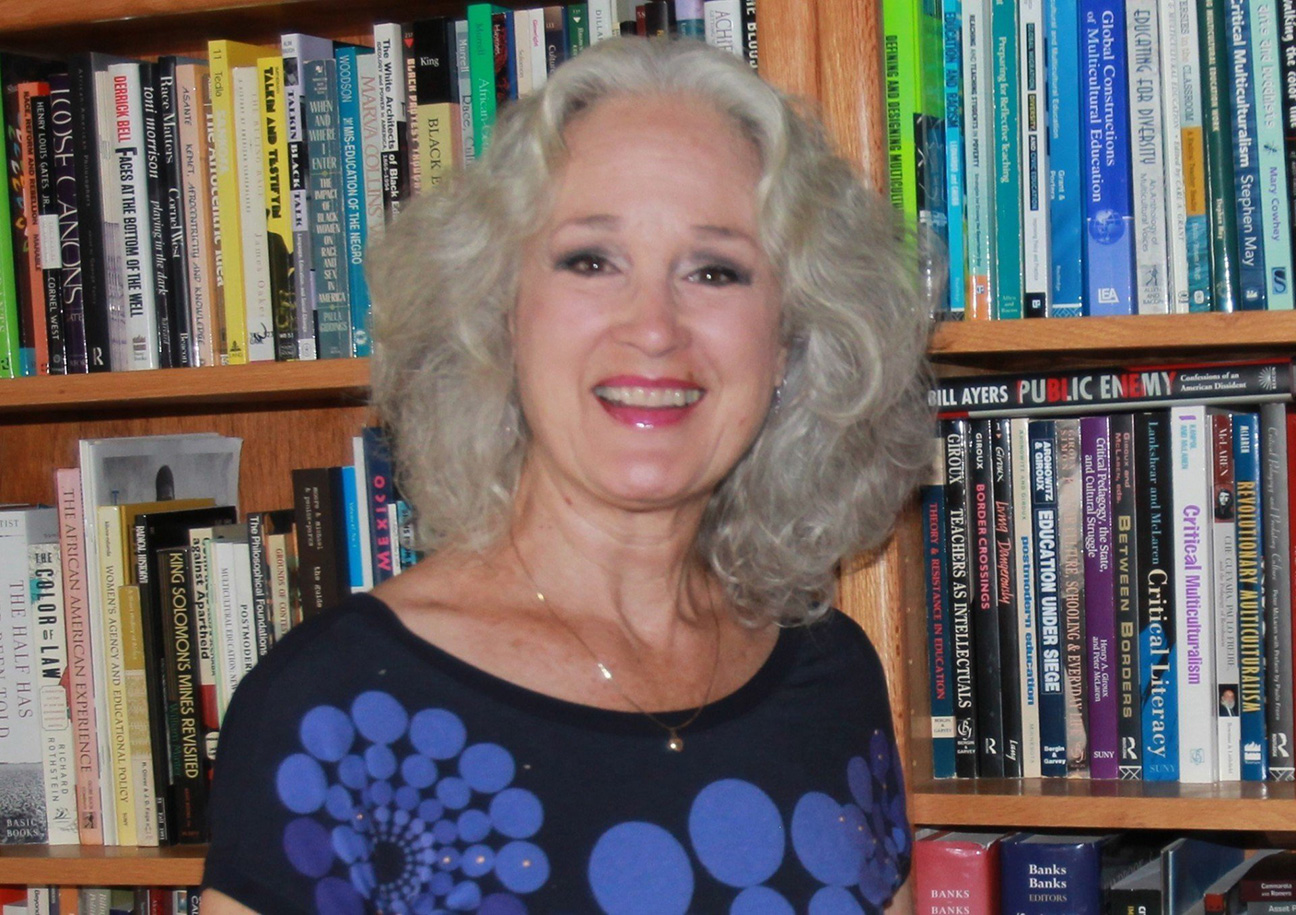| FEATURED
by Claudia Meléndez Salinas
Wouldn’t you know it? Monterey County is home to one of the country’s foremost experts in ethnic studies and multicultural education — and she happens to be a white woman.
Christine Sleeter, one of the founding faculty members of Cal State University Monterey Bay, has written 24 books, most of them on teaching, plus three novels. She is a member of the National Academy of Education and has received a plethora of awards, including the Chapman University Paulo Freire Education Project Social Justice Award, and the National Association for Multicultural Education Research Award.
If you Google “ethnic studies curriculum,” chances are her book “Transformative Ethnic Studies in Schools: Curriculum, Pedagogy, and Research,” co-authored with Miguel Zavala, will pop up near the top. Curious about her take on the current ethnic studies and critical race theory brouhaha, Voices of Monterey Bay co-founder Claudia Meléndez Salinas reached out to her. The interview has been edited for length and clarity.
VOMB: How did you find the time to write so much?
CS: (Chuckles) I’ve been at it for a long time. Writing helps me think. The ethnic studies report in particular, I was asked by the NEA (National Education Association) to do that. But, yeah, writing is how I think.
VOMB: Is there a link between ethnic studies and critical race theory? If so, what is it?
CS: Yes and no. The link that exists is that a lot of faculty members who work in ethnic studies have also studied CRT and use CRT as a framework that helps analyze how race works.
CRT actually is a theoretical perspective that comes out of legal settings, developed by legal scholars of color after the civil rights movement. The belief was: if we (change) laws so they no longer support racism, if you get rid of discriminatory laws, the system is going to work more fairly.
And when that didn’t happen, when the laws were changed but people of color still experienced racism on an everyday basis that was like ,ok, what is going on here? How can we understand race and how race works — so we can figure out what to do about it? That’s essentially what CRT does, it looks at systemic racism that is both embedded within the law as well as embedded within the institutions of (the United States). CRT isn’t something that’s taught in K-12 … that would be like saying that in K-12, in science, we teach electrical engineering, and we don’t.
VOMB: Both CRT and ethnic studies have been around a while. CRT for 40 years, and ethnic studies at least since the Vietnam era days, when Chicanos pushed and got more ethnic studies courses at some colleges. Why the attack now?
"White people grow up learning not to talk about racism, that if you talk about racism then you’re being racist and you’re creating racism and it is better not to talk about it and it’ll go away, and that’s a really common belief." Christine Sleeter
CS: Some of this was started by a guy name Christopher Ruffo, he apparently decided that Republicans could win the next election if they had a way of convincing the general public that the Democrats have fallen off the deep end, and a way of doing that is to take critical race theory and use it as a bucket for anything having to do with race and racism that Democrats talk about — which is not what it is — and the public has been convinced by a lot of writing that’s been done by the right, that CRT is anti-democratic, anti-American, that teaches hate. It isn’t any of those things but that’s what the public has grown to think.
It’s working, it’s getting particularly white people upset. States have been passing laws you can’t teach anti-racism in some states, and that’s running head to head with the ethnic studies movement, particularly in Texas, which is basically saying that you can’t teach about racism. It relates to (white) people’s fears about becoming a minority, and ethnic studies for a lot of people is scary. There’s a lot of fear that’s been pandered to.
VOMB: Why is this so scary to white people
CS: I don’t think it’s scary personally, but white people are afraid of losing power. I have spent a lot of time teaching white education students, and white teachers about racism. White people grow up learning not to talk about racism, that if you talk about racism then you’re being racist and you’re creating racism and it is better not to talk about it and it’ll go away, and that’s a really common belief. If white people haven’t had constructive ways of thinking about racism, talking about racism, working on racism then it’s like “I’m going to say the wrong thing, I’m going to do the wrong thing,” and then it’s like, “Wouldn’t it just be better if we just told the kids to work hard and the system will work for you”? I don’t know …
I grew up in a predominantly white area of south Oregon. I did not have much exposure to race, racism and people of color. After graduating from college I was a teacher in a prep program in inner city Seattle. It was a confrontation with different realities that I grew up with.
I don’t think I ever felt threatened and afraid, but I’ve seen a lot of white people feel it. But I do remember feeling ignorant, feeling like I was saying the wrong thing. Over time, developing relationships with people and reading a lot ethnic studies work … I started re-educating myself. I started reading the autobiography of Malcolm X, Chicano history books. I felt ignorant, but over time it helped me fill out the gaps of what I knew about America. I realized I’d only gotten this slice of education. We still do that in schools.
Over time, what it did, it gave me a much richer and fuller perspective of America. I grew up learning white people’s history and culture and literature and art, and that was all. Today the textbooks have people of color sprinkled into white people’s narratives, and kids of color often see that but white people and white kids don’t. So they think that the curriculum that they’re getting is already inclusive and they don’t realize that there’s a lot of non-inclusiveness there, even though on the surface it looks like it’s multicultural
"You can’t go back and undo history, redo history. But you can at least try to find the places where you may be able to either give back what was stolen or in some other way try" Christine Sleeter
VOMB: Your book “Transformative Ethnic Studies in Schools: Curriculum, Pedagogy, and Research” has the following description: Explores how the traditional curriculum is not ideologically neutral and the effect that has on both students of color and White students. Tell me more about that.
CS: There’s been quite a number of studies in which researchers have interviewed students to find out their perspectives about schooling … And starting in elementary school some students of color are aware that what they’re learning in school is different from what they’re learning at home and their communities. They’ll be learning in schools that everybody has rights and they’ll be learning at home and in their community that black people do not always have rights, so they can see that there’s this discrepancy.
By the time the kids get to middle school and high school, a lot of students of color just see gaps between what they’re being told in school and what they learn at home. Sometimes it’s gaps, stuff that has been left out, and sometimes it’s contradictions. What I’ve been told from a number of ethnic studies teachers is that, when kids are encountering a curriculum that’s generated from the ground up, from the perspectives of people in the communities they’ve grown up in… it starts igniting a degree of academic interest, an intellectual awakening that you weren’t getting when you were being taught a whitestream curriculum.
Teachers will often blame the kids when they don’t seem interested in school. They’ll say things like “The kids are not getting too much support from home or the community, they don’t get supervision, that’s why they’re not doing well in school.” But ethnic studies teachers say when you shift what’s happening in the classroom so it supports and builds stories, perspective and understanding about what the kids bring to school, kids start blossoming intellectually.
VOMB: Is there a way to make these concepts more accessible to the general public? Is that why you decided to write fiction?
CS: I have tried to write fiction for the general public. “Family History in Black and White” compares two teachers, one of them white and one of them black, they both really good teachers, as they’re trying to become superintendents and what vision they have in education – it’s fiction and it has romance.
For me, it took a whole lot of reading and deciding that I was going to read a whole lot of stuff that I didn’t know very well. It’s hard to talk in the abstract about Mexican American studies if you haven’t read any of the literature or any of the history or don’t know any of the artists. Then it’s just words on a page. There’s so much literature out there. “Interior Chinatown” is a novel, it critiques how dominant Anglo society casts Chinese Americans in this limited range of roles they can occupy. You can learn a lot by reading this piece of fiction.
VOMB: In 2017 you gave $250,000 to the UTE tribe as compensation for the profit your great grandparents made when they sold tribal lands. Do you think money can compensate for something like this?
CS: No, but money helps. They were going to use it for building a new high school. For me it was more recognizing and trying to get other white people to recognize that our families have built wealth on stolen land and on stolen labor. You can’t go back and undo history, redo history. But you can at least try to find the places where you may be able to either give back what was stolen or in some other way try to … that’s what the whole issue of reparations (is about).
It was hard for me to come to terms with this. I struggled. I was working on my second novel, I looked for evidence of homesteading and could not find it. When I found evidence a homestead was granted, all these pieces fell into place. I plowed around several months before I made a personal connection and then it was really easy to move forward after that. “The Inheritance” fictionalizes it in a specific kind of detail.
What I really want people to understand is that the research supports ethnic studies for people of color but also for white students. The great majority of studies are very positive of ethnic studies. People can get into discussion but if we try to think what research says helps our kids, this is one of those things that does.
Enlarge

Books by Christine Sleeter | Provided photo
Have something to say about this story? Send us a letter.
